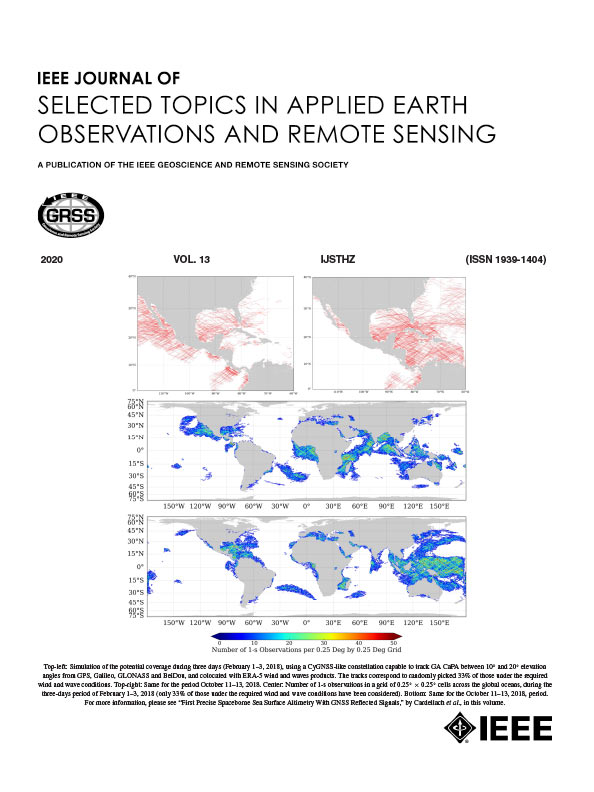基于神经结构搜索的多光谱卫星图像主动火灾检测分类器设计
IF 4.7
2区 地球科学
Q1 ENGINEERING, ELECTRICAL & ELECTRONIC
IEEE Journal of Selected Topics in Applied Earth Observations and Remote Sensing
Pub Date : 2025-04-01
DOI:10.1109/JSTARS.2025.3556550
引用次数: 0
摘要
野火的破坏性越来越大,及早发现野火对于遏制野火至关重要。近年来,基于深度学习的野火探测系统的复杂性急剧增加,为了管理这种增加的复杂性,人们提出了自动设计神经网络架构的技术。此类技术通常被称为神经架构搜索(NAS)。本文展示了如何使用基于强化学习的神经架构搜索(NAS)代理来设计一个小型神经网络,以便在多光谱卫星图像上执行主动火灾探测。具体来说,我们的目标是自动设计一个神经网络,该网络可以确定单个多光谱像素是否是火灾的一部分,并在功率预算有限的低地球轨道超小型卫星的限制条件下完成这项工作,以方便对传感器数据进行星载处理。使用一个回归模型作为奖励函数,该模型可预测特定结构在量化后获得的 F1 分数。该模型是根据神经网络架构样本的分类性能统计进行训练的。除了 F1 分数,我们还在奖励函数中加入了参数总数,以限制所设计模型的大小。最后,我们将最佳神经网络部署到 Google Coral Micro Dev Board 上,并对其推理延迟和功耗进行了评估。该神经网络包含 1716 个参数,推理平均需要 984 美元/分钟,推理功耗约为 800 mW。这些结果表明,我们的方法可以应用于新问题。本文章由计算机程序翻译,如有差异,请以英文原文为准。
Designing a Classifier for Active Fire Detection From Multispectral Satellite Imagery Using Neural Architecture Search
Wildfires are becoming increasingly devastating, and detecting them early is essential to containing them. Deep learning-based wildfire detection systems have increased in complexity dramatically in recent years, and in order to manage this added complexity, techniques have been proposed to automate the design of neural network architectures. Such techniques are usually referred to as neural architecture search (NAS). This article showcases the use of a reinforcement learning-based neural architecture search (NAS) agent to design a small neural network to perform active fire detection on multispectral satellite imagery. Specifically, we aim to automatically design a neural network that can determine if a single multispectral pixel is a part of a fire, and do so within the constraints of a low earth orbit nanosatellite with a limited power budget, to facilitate on-board processing of sensor data. A regression model that predicts the F1 score obtained by a particular architecture following quantization is used as a reward function. This model is trained on the classification performance statistics of a sample of neural network architectures. Besides the F1 score, we also include the total number of parameters in our reward function to limit the size of the designed model. Finally, we deployed the best neural network to the Google Coral Micro Dev Board and evaluated its inference latency and power consumption. This neural network consists of 1716 parameters, takes on average 984 $\mu$
求助全文
通过发布文献求助,成功后即可免费获取论文全文。
去求助
来源期刊
CiteScore
9.30
自引率
10.90%
发文量
563
审稿时长
4.7 months
期刊介绍:
The IEEE Journal of Selected Topics in Applied Earth Observations and Remote Sensing addresses the growing field of applications in Earth observations and remote sensing, and also provides a venue for the rapidly expanding special issues that are being sponsored by the IEEE Geosciences and Remote Sensing Society. The journal draws upon the experience of the highly successful “IEEE Transactions on Geoscience and Remote Sensing” and provide a complementary medium for the wide range of topics in applied earth observations. The ‘Applications’ areas encompasses the societal benefit areas of the Global Earth Observations Systems of Systems (GEOSS) program. Through deliberations over two years, ministers from 50 countries agreed to identify nine areas where Earth observation could positively impact the quality of life and health of their respective countries. Some of these are areas not traditionally addressed in the IEEE context. These include biodiversity, health and climate. Yet it is the skill sets of IEEE members, in areas such as observations, communications, computers, signal processing, standards and ocean engineering, that form the technical underpinnings of GEOSS. Thus, the Journal attracts a broad range of interests that serves both present members in new ways and expands the IEEE visibility into new areas.

 求助内容:
求助内容: 应助结果提醒方式:
应助结果提醒方式:


